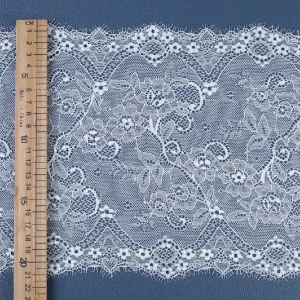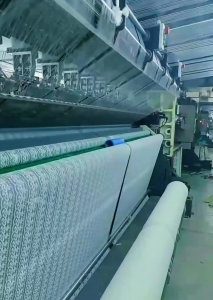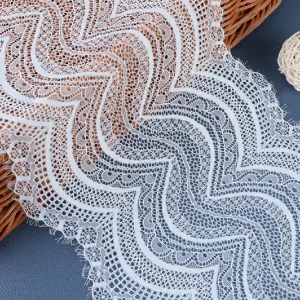Short Description:
This article provides a detailed B2B comparison between soft embroidered edges and rigid lace borders, analyzing production costs, stability, raw material supply, and factory line adaptability to guide large-scale purchasing and sales strategies.
Table of Contents
What distinguishes soft embroidered edges from rigid lace borders in craftsmanship?
Soft Embroidered Edges:
Rigid Lace Borders:
- Created with structured, often thicker threads or woven patterns that produce firm, well-defined edges.
- Provide strong visual accents and durability but have less flexibility.
What distinguishes soft embroidered edges from rigid lace borders in craftsmanship?
What are the key differences between embroidered lace and regular lace?
- Embroidered lace combines delicate lace structures with detailed embroidery, resulting in raised, textured designs, whereas regular lace features openwork patterns created by looping threads.
How do merrowed and hot-cut borders differ in patch design?
- Merrowed borders provide a thick, uniform edge ideal for symmetrical shapes, while hot-cut borders offer a thin, flat edge suitable for intricate, custom shapes.
How do production costs vary between soft embroidered edges and rigid lace borders?
- Soft embroidered edges typically require less material but might entail more detailed embroidery work, impacting labor costs.
- Rigid lace borders use more yarn and denser stitching or weaving, increasing material costs but benefiting from standardized industrial production.
- Overall, production costs can be comparable; choices depend on design complexity and order scale.
What factors influence the cost of producing lace fabric?
- The complexity of the lace design significantly affects its price; intricate patterns require more time and expertise, increasing costs.
Is embroidered lace more expensive to produce than regular lace?
Which option offers superior stability and consistency in bulk manufacturing?
- Rigid lace borders excel in stability due to their firm construction, maintaining shape under various processing and wear conditions.
- Soft embroidered edges, while flexible, may present minor variations in tension and edge durability, requiring careful quality control.
Are merrowed borders more durable than hot-cut borders?
- Merrowed borders are known for their durability and resistance to fraying, making them suitable for patches subjected to regular wear.
How does the manufacturing process affect lace fabric quality?
- The precision of the weaving process and the quality of materials used are critical for ensuring consistent quality in lace production.
What are the differences in raw material sourcing and supply chain risks?
- Both use similar fibers—cotton, polyester, or blends—with stable global supply chains.
- Soft embroidered edges may rely on diverse thread types to achieve softness, potentially complicating sourcing consistency.
- Rigid lace borders depend on specialized thick yarns or woven lace modules but generally benefit from mature supplier networks.
What materials are commonly used in lace production?
- Lace can be made from various materials, including cotton, linen, silk, and synthetic fibers like polyester or nylon.
Are there supply chain risks associated with lace fabric materials?
- Supply chain risks for lace fabric include variability in raw material quality and availability, which can impact production consistency.
How adaptable are soft embroidered edges and rigid lace borders to factory production lines?
- Rigid lace borders are well-suited for automated weaving and edge finishing machines, supporting high-throughput production.
- Soft embroidered edges require sophisticated embroidery machines and may slow production lines due to customization and finishing needs.
- Factories with flexible machinery can integrate both; otherwise, rigid borders facilitate easier scaling.
Do factories need specialized equipment to produce embroidered lace?
Can existing weaving machines be used for both lace types?
- While some machinery can handle both types, additional equipment and processes may be needed for embroidered lace.
Which type of lace edging is more advantageous for large-scale procurement and market growth from a B2B perspective?
- Rigid lace borders are optimal for large volume orders due to cost efficiency, durability, and manufacturing convenience.
- Soft embroidered edges serve higher-end or specialty markets valuing fabric feel and design subtlety but at a generally higher production cost.
- B2B buyers should align product positioning and desired fabric aesthetics with operational capabilities when selecting between these options.
Is embroidered lace popular in the B2B market?
- Embroidered lace is popular for high-end fashion and bridal wear, but its production complexity may affect large-scale procurement.
What factors should businesses consider when choosing lace types for bulk purchasing?
- Businesses should consider production costs, demand trends, manufacturing capabilities, and material availability when choosing between lace types.

John Gan
John Gan specializes in professional lace and fabric customization, leading Shaoxing Yituo to expand globally with quality and innovation. He is committed to making the company a leading supplier through strong international partnerships.




